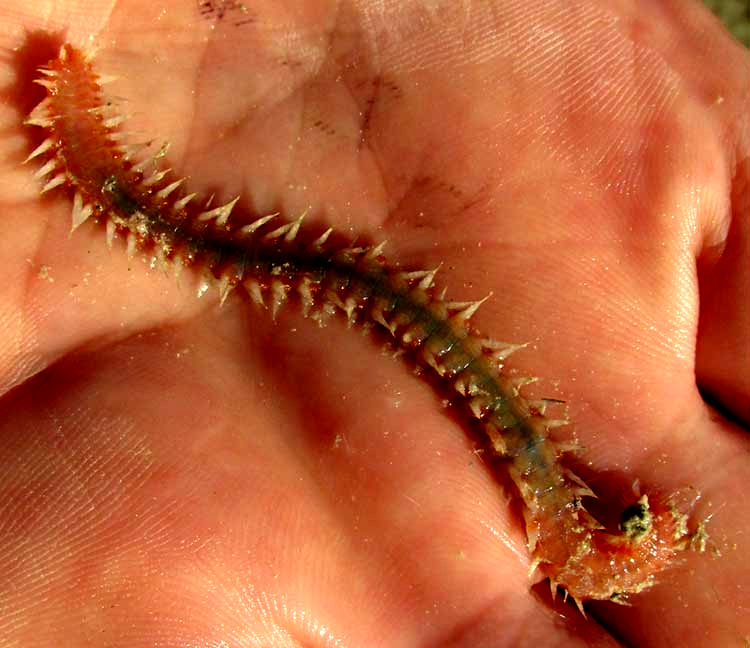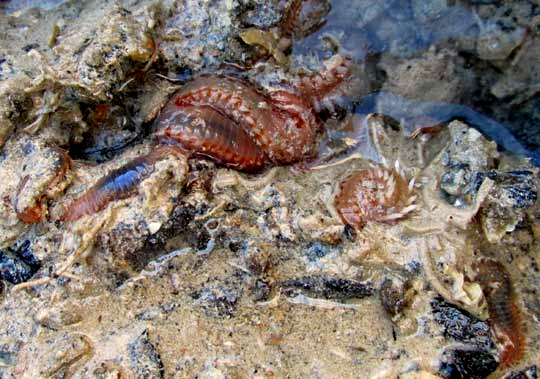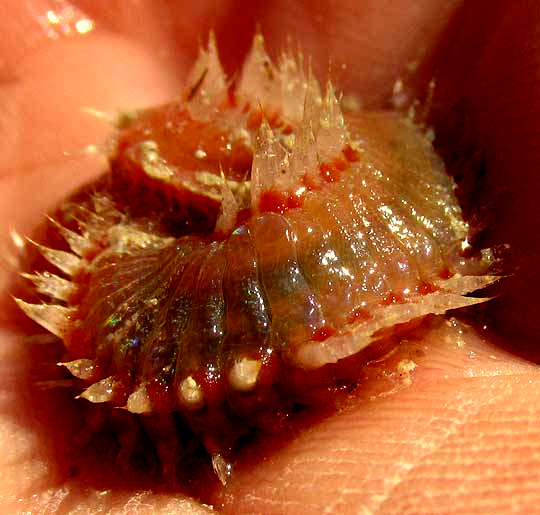Excerpts from Jim Conrad's
Naturalist Newsletter

from the March 8, 2015 Newsletter issued from Río Lagartos, on the Yucatan Peninsula's northern coast (~N21.60°, ~W88.16°), Yucatán state, MÉXICO
FIREWORMS
At low tide, some particularly slimy looking gunk was pooled inside an old, abandoned, mostly rusted-away dredging pipe, and one part of the slime was working with worms. You can see the mess below:

The worms were pinkish and wrapped around one another like mating earthworms, but this habitat was too wet for earthworms. In other words, probably these were yet another form of polychaete, polychaetes being a huge, very diverse group of bristle-equipped, segmented worms, of which we've been seeing many kinds in our local estuarine and marine environments. I separated a worm from its mud, nudged into the palm of my hand, washed it off, and below you can see it curled up there:

The worm's segmentation is easy to see, as well as the disposition of its spines -- two lines of them, one above the other, on both sides. In that picture the spines look as if they're very thick-based, or "bulbous," narrowing to extremely sharp tips, as we've seen in stinging plant hairs where toxins are stored in the bulbous bases. However, what seem to be single, thick-based spines are really tufts of very fine spines held together by adhesive forces. The slender, pliable spine tufts are behaving like soft bristles of a watercolor brush. When submerged, the bristles spread away from one another, but when removed from water they adhere to one another forming a single, sharp-pointed brush. In the picture, the bottom-most spines sopping water from my hand better display their tufted nature. This matter is important because the vast majority of pictures of this creature on the Internet show submerged worms with obvious tufts of bristles, not the broad-based, sharply pointed ones ours seem to have.
Soon the curled-up worm began uncoiling itself, surprising me with its length, expanding like an accordion opening up, but much more so, as shown at the top of this page.
This is the Fireworm, sometimes called Orange Fireworm, EURYTHOE COMPLANATA. The fire in its name possibly relates to its pinkish hue, but most probably it refers to the fact that the worm can deliver a painful sting with those tiny, white bristles along it body edges. I read that its bristles, or setae, are hollow and contain venom, and that they can break and stay in one's skin, causing long-lasting pain. I wasn't stung, and it's hard to imagine such a small worm with such fine hairs delivering much of a sting, but ours is a small one. They reach about six inches long (15cm).
Fireworms often are abundant in shallow, tropical, marine waters. In earlier years they were regarded as worldwide in distribution, but lately studies have indicated that several look-alike species probably are involved, so now some experts say that our Eurythoe complanata is limited to the tropical Western Atlantic -- the Caribbean to southern Brazil.
The Fireworm's favorite food is carrion. It moves around at night, and during the day can be found under rocks, inside calcareous algae and corals, or buried in soft sediments, like ours. They have a complex sexual reproductive cycle involving a freely floating "trochophore larva" stage, but also it can reproduce by fragmentation. When broken into pieces, each part grows a head and tail, and becomes a complete worm.
And Fireworms are indeed polychaetes, members of the family Amphinomidae, of which Fireworms are the best-known members. In general, polychaetes are considered to be the most "primitive" of living annelids -- to most closely resemble the common ancestor of all segmented worms, and maybe even all segmented animals. Our view of them enmeshed in gray goo evokes the notion of primitive life in primordial slime, and that may be close to the way it really was early in the history of Life on Earth.